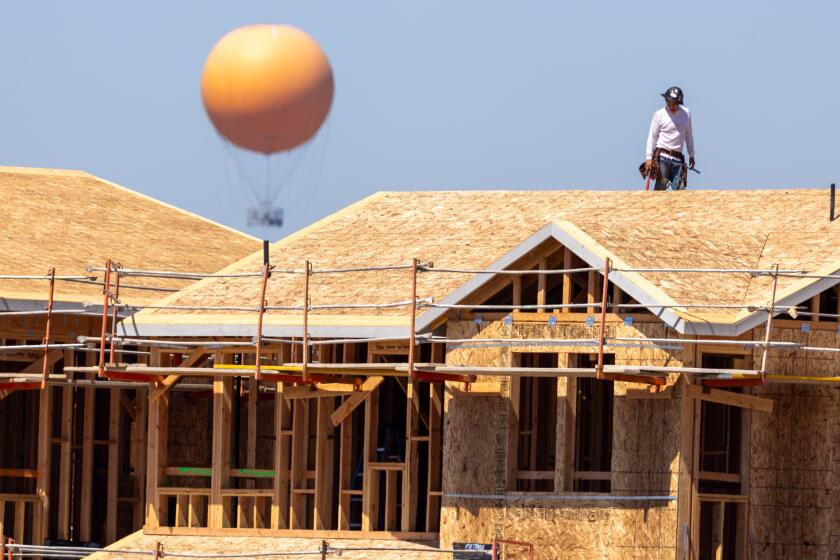L.A. fires hit family wealth. Daunting challenges await those trying to recover it

- Share via
- Three sisters whose homes were destroyed in the catastrophic wildfire in Altadena are attempting to recover the wealth they have lost.
- Like thousands of others whose homes were destroyed in the Los Angeles fires, the sisters face myriad challenges rebuilding, including cleanup delays and rising construction costs.
- After previous California wildfires from 2013 to 2020, almost 40% of homeowners’ insurance claims were underpaid, according to research by Federal Reserve Bank economists.
It took a decade of scrimping and saving for the Ramirez sisters to buy their first house, a fixer-upper in Altadena. Nine years later, they bought another, and after a few more years, a third, all within a few blocks of each other.
By 2013, the three single women all had their own homes, and they enjoyed watching their properties rise in value to more than $1 million each — the kind of wealth that their immigrant father, a California bracero, could never have imagined.
Now, after the Los Angeles fires burned all three homes to the ground, the Ramirez sisters are back to square one.
Coverage of the firefighters’ battle to improve containment over the Eaton and Palisades fires, including stories about the latest death count and victim frustration.
They are once more living together in one house, a four-bedroom short-term rental in San Fernando, paying almost $8,000 a month. And they’re again pooling their funds as they look to buy a house together: Their goal, just as before, is to continue living together until each of them rebuilds her own home — and regains the wealth they have lost.
That’s a daunting challenge, and how close the Ramirez sisters come to success may determine how bright the future of much of Los Angeles turns out to be.
To begin with, like the owners of many of the almost 12,000 homes destroyed by the fires, the Ramirezes are likely to find they’re underinsured. Their policy coverage limit may not be enough to rebuild similarly sized houses on their lots, or their final settlement may be negotiated down to less than what they might otherwise get, which is common.
After previous California wildfires from 2013 to 2020, almost 40% of homeowners’ insurance claims were underpaid, with households receiving settlements that were 28% lower than the expected rebuilding costs, according to research by Federal Reserve Bank economists in San Francisco and Philadelphia. The gap may be even bigger today because of the expected surge in cost due to unusually high demand for contractors and supplies.
All of which means the Ramirezes will need to take out a loan on top of the mortgages they already have on their incinerated houses. Losing a house in a fire or other disaster does not cancel a preexisting mortgage. So rebuilders may need to work more or longer than they had planned in order to meet the extra expenses. And the rebuilding process will be long and grueling, further complicated by the Trump administration’s crackdown on unauthorized immigrant workers who are a critical source of labor for construction and other industries.
The cleanup alone will take many months.
“I’m hopeful, but I’m a little scared,” said Teresa Ramirez, a social worker who at 58 is the oldest of the three sisters. On Saturday, she and her sisters, Alicia and Maria, their brother, Tony, and Teresa’s son, Leo, went together to see the charred remains of their homes. All that is left standing at Teresa’s house are the chimney and fireplace, a metal fence and two orange trees in the back.
The destruction caused by the Palisades and Eaton fires is staggering. Total economic damage has been estimated as high as $250 billion.
What homeowners lost is certainly in the tens of billions of dollars. Some didn’t have fire insurance at all. Many of those who are covered saw a substantial part of the equity that they had amassed over many years suddenly vanish.
For most people, the home is their primary asset, their nest egg and source of financial security. It’s also the foundation of generational wealth — wealth that could be passed on to their children for education, raising families, starting a business and other things that can make future generations stronger and more secure. Historically, that kind of progress has made communities and whole countries grow stronger.
Along the way, those promising futures have helped bridge economic and generational divides, brought a level of social cohesion to neighborhoods and spurred broad growth.
The question facing both individuals hoping to rebuild and the larger communities they belong to is whether, and how widely, that dynamic prevails after a catastrophe as enormous as the L.A. County fires.
“Those homes represented social stability and transferred wealth in a multiethnic community,” said G.U. Krueger, a longtime Los Angeles housing economist who has done work for the California Public Employees’ Retirement System, among other clients.
“Grandparents, parents and their children could support each other through their life stages in celebrating their successes and helping in times of economic and social stress,” Krueger added. “They represented a haven of stability in a chaotic world, which could soon be a utopian memory.”
In Altadena, the heart of the Eaton fire, some 6,000 homes, or about 40% of all residential units, were destroyed, according to census data and a Times analysis. Before the fires, it was a middle-class city with mostly older homes (built before 1960) and a diverse population of 43,000 that was about half Latino and Black.
Many bought into the community decades ago when it was far cheaper, and over time experienced significant appreciation. As of December, the average price of a home in Altadena was about $1.2 million, a fivefold increase from 2000, based on data from Zillow.
Most have substantial equity in their homes. Some have paid off their loans, or nearly so.
Teresa Ramirez’s neighbor on Olive Avenue, Paul Wallace, a retired civil engineer, bought his three-bedroom house 23 years ago. He has just 2½ years left on a 15-year mortgage, and says he has reserves to pay that off. Wallace plans to rebuild, although he, too, worries about the cost.
Before the devastating fires burned across Los Angeles, many homeowners learned they were losing their insurance policies. Some faced big increases in premiums that they couldn’t afford.
Others, after refinancings and cash-outs, have bigger mortgages. Teresa Ramirez’s is $460,000. Overall, homeowners in Altadena, on average, carried a mortgage balance of $515,000 at the end of last year, according to Moody Analytics’ analysis of credit files for The Times.
The Palisades fire, by comparison, destroyed more than 5,500 homes, about 60% of all residential units. The city of 21,500 is older (median age 47), richer (median household income over $200,000) and more than half of the houses were built after 1960.
Palisades home values, on average, have more than doubled since 2010 to $3.7 million. With an average mortgage balance of $1.7 million, the typical owner had racked up $2 million of equity wealth as of last year. Its residents include the rich and famous, as well as other well-to-do individuals who have personal resources to rebuild.
But there are also homeowners who bought decades ago when homes weren’t as pricey, and others who lived in more modest units.
Katia and Adam Hausman said they stretched to purchase a Pacific Palisades condo in 2012 for just under $550,000. In the years that followed, they advanced in their careers, remodeled their unit and brought their daughter, Mila, home from St. John’s Hospital, turning their two-bedroom dwelling into a place of safety and comfort.
Last month, they watched live on TV as their home burned.
The couple said they want to return and think their insurance will cover the cost to rebuild the interior of their condo. But that’s only one piece of the puzzle.
Adam Hausman, a real estate broker, said he’s not sure their homeowners association’s master insurance plan will be enough to reconstruct the exterior of the building. If the money is there, the process won’t be quick. Hausman, 53, estimates it would be five years until they could move back in.
In the meantime, they’ll need to pay the mortgage on their destroyed condo, as well as costs for temporary housing, expenses Hausman said their insurance isn’t close to covering.
To make it work, the couple set up a GoFundMe page and are prepared to move somewhere they can live cheaper for now.
“We cannot afford to do this in Los Angeles,” said Katia Hausman, 47, who works in technology.
Wildfires, in particular, throw up additional barriers for people to rebuild.
The Eaton fire destroyed thousands of structures in Altadena and Pasadena. Now, residents grapple with how they can afford to rebuild.
Unlike after a flood when water recedes, fire often leaves behind lots of toxins that can require expensive remediation that can also delay insurance payouts. It can take up to 18 months for the Army Corps of Engineers to assess and remove debris, including hazardous materials, and prepare soil reports before construction can begin.
Homeowners who aren’t well-off often hit a wall, unable to pay for the litany of costs. Eventually such households throw in the towel and sell to developers or wealthier individuals. Others settle for what they can get from insurers, pay off their mortgages and leave the area.
Government disaster recovery aid from the Federal Emergency Management Agency and elsewhere is supposed to lessen the chance of that happening, but financial assistance is often slow to arrive.
“Unfortunately, we have a housing recovery system that is extremely broken from a policy perspective and it gets worse the further down the income and wealth ladder you go,” said Andrew Rumbach, a senior fellow with the Urban Institute think tank.
After the Tubbs fire in 2017 destroyed more than 2,600 residential properties in Santa Rosa, the city made extraordinary efforts to manage the rebuilding process and hired an outside firm to help with permitting and other logistics. Even then, more than seven years later, one-fifth of what was lost has still not been reconstructed, according to the city’s recovery data.
The rebuilding pace may be faster in L.A. because the city, the county and the state have pledged to speed up the recovery. Yet experts say it could still take a decade to fully rebuild in the Palisades and Altadena. Planning departments are understaffed and contractors are expecting a shortage of key materials such as lumber and drywall.
The Ramirez sisters are bracing for a long haul but are determined to rebuild.
“We’re not going anywhere,” said Teresa, recalling how their father first came to California from Michoacan, Mexico, in the early 1960s under the U.S.-Mexico bracero program for temporary farmworkers.
Teresa and her sisters grew up in Pasadena and settled in Altadena in 1993. They took the time-honored path to building wealth: education and homeownership.
L.A.’s wildfire recovery may be on a collision course with Trump’s immigration policy. Southern California’s construction industry is heavily reliant on immigrant labor.
All three got college degrees and steady jobs. And after years of renting, they bought their first house in Altadena for $190,000 in 2001: a four-bedroom, two-bath rambler that was so run-down that it was barely livable. They fixed or replaced the kitchen and roof, plumbing and electricity, and more. Before the fire, the house was worth more than $1 million.
In 2010, grieving for the passing of their homemaker mom, the sisters decided it was time to buy house No. 2. They paid $390,000 for the three-bedroom, two-bath house. It was just two minutes away from the first house and Teresa and her young son would live in it.
At the start of this year, it was valued at $1.1 million.
The sisters bought the third house in 2013, several blocks away, just past Odyssey Charter School, paying $490,000. A month ago, it was worth more than $1.2 million.
“That’s a lot of money for working-class, single women,” Teresa said.
She wants to rebuild what she had before, which should make getting permits faster than submitting plans for something bigger or different.
But she worries about higher costs. Some rebuilders are wanting to use more metal and fire-resistant materials and even sprinklers on the roof.
Teresa says her insurance policy from the Hartford, which includes extended coverage, will pay up to $930,000 for a replacement structure. She fears rebuilding could cost up to $1,000 per square foot — which means she would have to come up with as much as $670,000 on her own to match the size of her old, 1,600-square-foot home.
Teresa’s neighbor, Paul Wallace, said he met with an architect about rebuilding, and she gave him a quote of $90,000 to $100,000 just for her services. And he would have to get a separate structural engineer, all before he even began rebuilding.
Still, companies such as Thomas James Homes, a single-lot builder in the Los Angeles area, say that a more basic new home, personalized but not custom-built, would probably cost closer to $600 per square foot, which could be more in line with Teresa’s budget.
The Ramirez sisters also have a GoFundMe page and are trying to move quickly, concerned that their Altadena location will put them at the back of the rebuilding line, especially behind wealthier places such as the Palisades.
“We don’t want to be a forgotten community,” she said.
More to Read
Sign up for This Evening's Big Stories
Catch up on the day with the 7 biggest L.A. Times stories in your inbox every weekday evening.
You may occasionally receive promotional content from the Los Angeles Times.
















